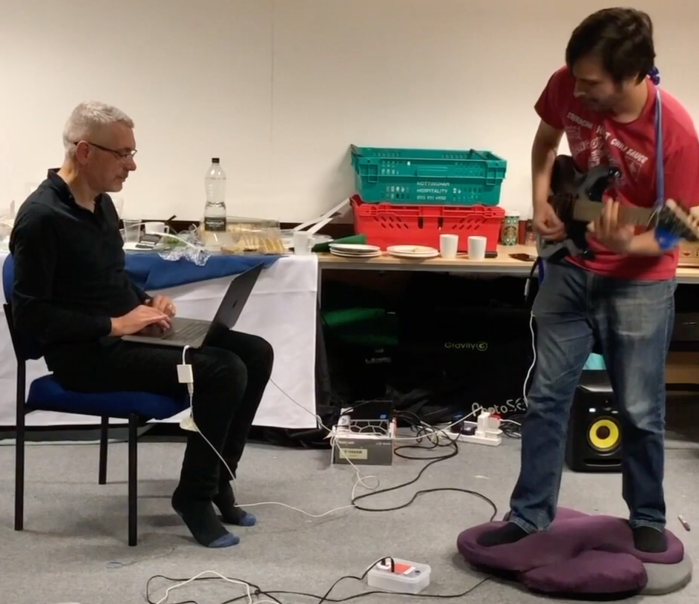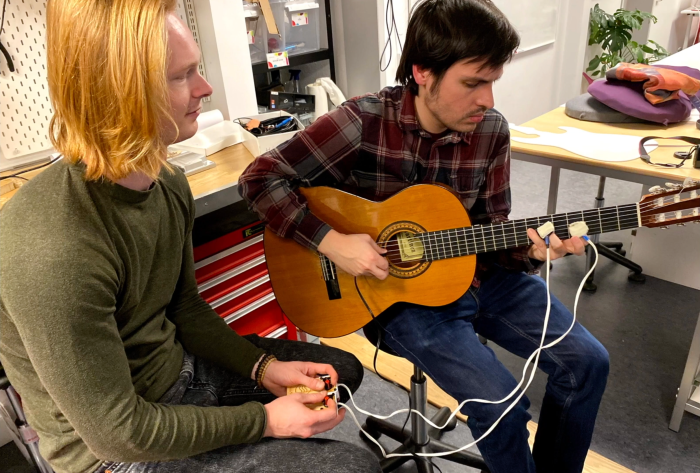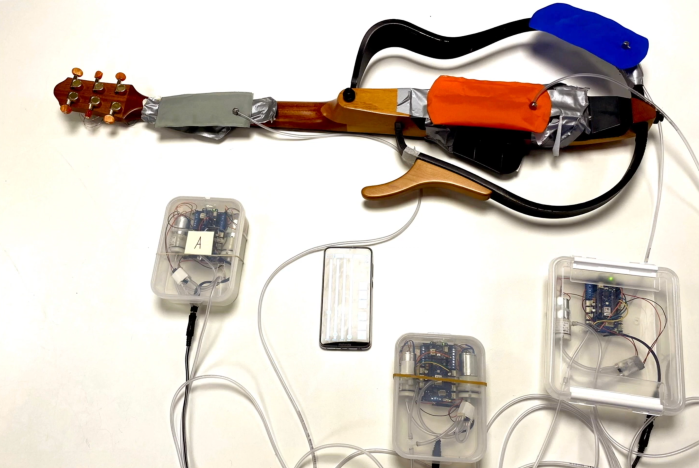Another delve into the word of guitar technology research. This time we consider how the application of an unusual design method called soma design led our team to a highly unusual guitar concept – a breathing guitar.
Soma design is an emerging method aimed at the design of bodily interactions, meaning ways of using digital technologies that engage the whole body rather than just the hands. Soma design is named after its inspiration, Philosopher Richard Schusterman’s practical philosophy of Somaesthetics that pursues the aesthetic and holistic appreciation of the soma – the body-mind. Its followers strive to attune their aesthetic sensibility, that is their deep appreciation of their own bodily experience. Soma design, a product design method pioneered by Prof Kia Höök and her team at The Royal Institute of Technology (KTH) in Stockholm, applies this thinking to the design of new products that involve bodily interactions. You can read more about the approach in Kia’s recent book ‘Designing with the Body‘.
Our team at the University of Nottingham’s Mixed Reality Laboratory (MRL) collaborated with the KTH team and also with the Centre for Digital Music as Queen Mary University London (see Post 67), to apply soma design to digitally augmented guitars with the goal of enhancing the player’s whole body experience of the instrument. You’ll find many previous attempts to digitally augment guitars in the literature, especially in the New Instruments for Musical Expression (NIME) conference series, which have tended to focus on generating new sounds or on controlling effects, the core business of playing the instrument. Our joint soma design explorations took us in a quite different direction, that of enhancing other, often neglected, aspects of playing the instrument such as posture and breathing. Ultimately, they led us to the very unusual idea of a breathing guitar …
MRL PhD student Juan Martinez Avila, whose PhD work is exploring augmented guitars (see Post 56 for some of his previous work on encumbered interaction with guitars), presented this work at NIME 2020 in July (as an aside Carolan first visited this conference back in Post 46 as part of its road trip to Louisianna). Here’s his ten minute talk …
For those who prefer the written word, read on …
We began with a three-day workshop at the MRL to generate new ideas, adopting ‘balance’ as an inspirational theme that reflected the movement and postural aspects of playing the guitar, often neglected in the design of conventional guitars and accessories. Each day began with a Feldenkreis session in which we tuned into to our own bodily sensations without the guitar, before we then picked up our axes for focused design sessions. These sessions used the ‘soma bits’ toolkit, a collection of technologies that allows different soft shapes and also vibrations, heat and pressure to be applied to different parts of the body , especially those parts that connect with the guitar, so as to alter the player’s awareness of their own bodily experience.


The application of soma bits inspired two unusual design concepts. The ‘Cushy Pedal’ was envisaged to be a large interactive platform for the floor that could be rocked back and forth by the player shifting their weight, somewhat like a pedal board combined made into a giant expression pedal. The idea was to encourage new kinds of expressive dance-like movements while simultaneously controlling different aspects of the sound or environment. We considered embedding vibrators and inflatable cushions into the unit to provide interactive feedback through the feet. The ‘Stretchy Strap’ was imagined to be an elastic guitar strap that could be stretched and (via embedded stretch sensors) could also be used as a control device. We fashioned ultra low-tech (non-functional) versions of both concepts using the soma bits and various soft materials and then tested out how they might feel by using the ‘Wizard of Oz’ design technique in which the player moved while a partner watched them and improvised the sound in response (playing the role of the system like the Wizard of Oz did in the film).

Our first impressions were that both prototypes had the potential to stimulate engaging and aesthetically intriguing whole body interactions with a guitar. Indeed, the strap was subsequently chosen for further development as part of Juan’s PhD work – more on this in a future post.
Several months later, we regrouped for a return match in Stockholm, a second workshop, this time exploring the theme of ‘tension’ from both a bodily and musical point of view. We also tackled some of the challenges from the first workshop, most notably how difficult it was to bridge the expertise gap between the ‘soma designers’ on the team, who were experts in somaesthetic design bit not guitar playing, and the guitarists, with their expertise in playing the guitar but not in soma design.
We tried various ‘defamiliarisation’ tactics to bridge this expertise gap, making the guitarist in the team less familiar with their guitars while at the same time enabling the non-guitarists to get some sensation of playing. Guitarists and non-guitarists played duets, each taking one hand (guitarists fretting the chords while non-guitarists strummed). We taped the guitarists’ fingers together or applied vibrations to their fingers to disrupt their normal experience. And we ran further Feldenkreis sessions to help everybody better tune into their own bodily experience of tension. All of these tactics helped open up our participants to new, less familiar, ways of approaching the guitar.


A key concept that emerged during this workshop was that of breathing. We recognised that breathing is important to regulating tension in the body, but is also something that guitarists may easily neglect as they focus instead on their hands and fingers. Holding one’s breath can increase tension, while breathing properly can help relaxation which may lead to a better playing experience and potentially help cope with performance nerves. Even though the guitar is not a wind instrument, breathing can be important to performances.


We used the inflatable soma bits to intervene in the sensation of breathing while playing, placing them between the instrument and various points on the players’ body and inflating and deflating them so as to gently draw attention to breathing. This lead to tour final design concept, that of a breathing guitar – one that can change its shape in response to and to affect its player’s breathing and through this their bodily appreciation and relaxation. This rapidly generated further ideas. What if the player could then squeeze the guitar in various places to control it in some way, perhaps modulating its sound or other effects?
We quickly constructed a simple low-fi prototype to try out this idea by attaching three inflatable soma bits to a guitar. Rather than Carolan, we chose a Yamaha Silent Guitar as it’s open frame made it easy to attach inflatable pads around it’s body (and it had also been easy to take on the flight to Stockholm!). One pad at the back pressed against the player’s body under the rib cage to draw their attention to their breathing. A second was positioned under their right arm so it could be squeezed like a bag pipe. The third was placed in the back of the neck so that when it was fully inflated the player would not be able to fret chords at this neck position. This rather weird placement led to the provocative idea that the guitar might push back against the player, refusing the be played in certain ways and encouraging them to improvise by shifting up or down the neck to play something different for a change. Trying it out felt pretty good – if understandably weird.
This final prototype suggests the idea of future guitars that can change shape to fit players’ bodies, gently raises awareness of breathing and other often neglected aspects of playing, and that, in the extreme, might behave more like a living and breathing creatures, being squeezed by the player and squeezing back as a way of opening up new musical and performative dialogues.
OK, so we ended up in a very weird place, and we’re not suggesting that anyone is going to manufacture a commercial breathing guitar in the near future. What our design exploration does reveal however is how adopting a fresh perspective on the experience of playing the guitar and a new design method can lead to radical product ideas. While breathing guitars do not seem likely in the near future, some of the other ideas we generated along the way such as the cushy pedal and stretchy strap may have more immediate promise as we’ll reveal soon …